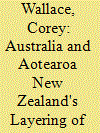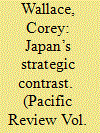| Srl | Item |
| 1 |
ID:
179944


|
|
|
|
|
| Summary/Abstract |
Around 2016, the Australian and Aotearoa New Zealand governments began to disassemble the coherent and optimistic imagery that had hitherto signaled their strategic commitment to accommodating China within an interdependent, prosperous, and strategically stable Asia-Pacific. While Canberra and Wellington remain committed to constructive "bedrock" bilateral relations and still avoid explicitly positioning China as a direct threat in their strategic messaging, both governments have increasingly communicated (1) concerns about their strategic vulnerability and military insecurity that requires enhanced military potency; (2) pessimism that great power competition could disrupt Asia-Pacific stability, requiring strategic diversification and cross-bracing with "Indo-Pacific" partners; and (3) stronger official criticism on narrower, strategically circumscribed issue sets as the two nations attempt to set acceptable terms for anticipated relations of greater future complexity with China. The targets of this "layered" approach to strategic communications are not only Beijing and Washington, DC, but increasingly other important regional partners and domestic stakeholder audiences with diverse interests.
|
|
|
|
|
|
|
|
|
|
|
|
|
|
|
|
| 2 |
ID:
167639


|
|
|
|
|
| Summary/Abstract |
Since 2008 the Japanese government has become more responsive to the exercise of Chinese economic, diplomatic and military power in Southeast Asia, suggesting an intensifying rivalry. The Japanese government has thrown off any reticence about self-promotion by more forcefully positioning Japan as a sensitive and sustainable strategic partner for Southeast Asian nations in a strategic contrast with the People’s Republic of China (PRC). Rather than trying to contain China, Tokyo is seeking to mediate how China turns its material resources into influence. Despite an increasing asymmetry in material resources between China and Japan, this article argues that Japan maintains a surprising ability to influence the preferences of Southeast Asian nations and responses to exercises of PRC power, which in turn has allowed Japan to influence China’s regional strategy.
|
|
|
|
|
|
|
|
|
|
|
|
|
|
|
|